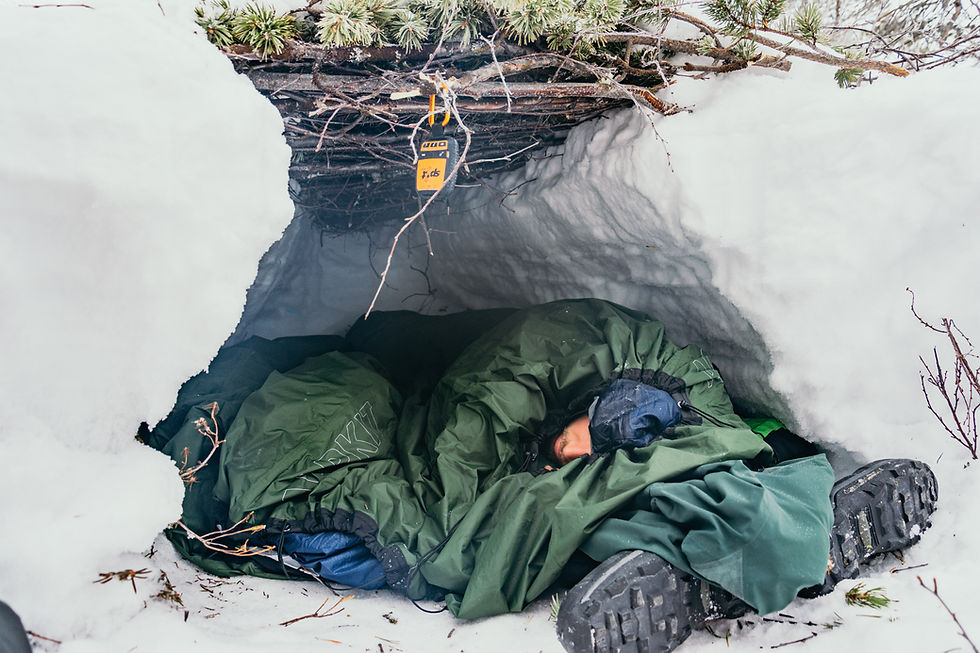Layering basics
- Mar 28, 2022
- 4 min read
Updated: Mar 29, 2022
Layering your clothing is a tried-and-true way to maximize your comfort in the outdoors.
The beauty of this simple concept is that it allows you to make quick adjustments based on your activity level and changes in the weather. Each layer has its own function. The base layer (against your skin) manages moisture; the insulating layer protects you from the cold; the shell layer (outer layer) shields you from wind and rain. You simply add or subtract layers as needed.


Your Base Layer: Moisture Management
This is your next-to-skin layer. It helps regulate your body temperature by moving perspiration away from your skin.
Keeping dry helps you maintain a cool body temperature in the summer and avoid hypothermia in the winter. If you've ever worn a cotton T-shirt under your raincoat while you hiked, you probably remember feeling wet and clammy, even though you weren't getting wet from the rain itself.
Cotton is a fabric that retains perspiration and can leave you chilled.
For outdoor comfort, your base layer should be made of merino wool (popularized by brands such as SmartWool, Ibex and Icebreaker), synthetic fabrics (polyesters such as Polartec Power Dry® or Patagonia Capilene®) or, for less-active uses, silk. Rather than absorbing moisture, these fabrics transport (or "wick") perspiration away from your skin, dispersing it on the outer surface where it can evaporate. The result: You stay drier even when you sweat, and your shirt dries faster afterwards.
Examples: A base layer can be anything from briefs and sports bras to long underwear sets (tops and bottoms) to tights and T-shirts. It can be designed to fit snugly or loosely. For cool conditions, thermal underwear is available in light-, mid- and expedition-weights. Choose the weight that best matches your activity and the temperature.
Your Middle Layer: Insulation

The insulating layer helps you retain heat by trapping air close to your body.
Natural fibers such as wool and goose down are excellent insulators. Merino wool sweaters and shirts offer soft, reliable warmth and keep on insulating even when wet. For very cold and dry conditions, goose down is best. It offers an unbeatable warmth-to-weight ratio and is highly compressible. Down's main drawback is that it must be kept dry to maintain its insulating ability. A new innovation—water-resistant down—promises to change this.
Classic fleece such as Polartec® 100, 200 or Thermal Pro polyester and other synthetics such as Thinsulate® provide warmth for a variety of conditions. They're lightweight, breathable and insulate even when wet. They also dry faster and have a higher warmth-to-weight ratio than even wool. Classic fleece's main drawbacks are wind permeability and bulk (it's less compressible than other fabrics).
Like thermal underwear, fleece tops are available in 3 weights:
Lightweight for aerobic activity or mild climates.
Midweight for moderate activity or climates.
Expedition-weight for low activity or cold climates.
Examples: For high-energy activities such as cross-country skiing, cycling or running, choose lightweight fleece (Polartec 100 or Power Dry) to avoid overheating. For cold conditions, try thicker fleece such as Polartec 200 or 300.
Wind fleece such as Polartec WindPro® polyester or Gore WindStopper®adds a high level of wind resistance to fleece. How? It uses a hidden membrane that does not affect breathability.
Your Shell Layer: Weather Protection

The shell or outer layer protects you from wind, rain or snow. Shells range from pricey mountaineering jackets to simple windproof jackets. Most allow at least some perspiration to escape; virtually all are treated with a durable water-repellent (DWR) finish to make water bead up and roll off the fabric.
An outer shell is an important piece in bad weather, because if wind and water are allowed to penetrate to your inner layers, you will begin to feel cold. Furthermore, without proper ventilation, perspiration can't evaporate but instead condenses on the inside of your shell.
Fit is another consideration. Your shell layer should be roomy enough to fit easily over other layers and not restrict your movement.

Shells can be placed into the following categories:
Waterproof/breathable shells:
The most functional (and expensive) choices, these are best for wet, cool conditions and alpine activities. Shells using laminated membranes such as Gore-Tex and eVent offer top performance; those using fabric coatings are a more economical alternative.
Water-resistant/breathable shells: These are best for light precipitation and high activity levels. Less expensive than waterproof/breathable shells, they're usually made of tightly woven fabrics (such as mini-ripstop nylon) to block wind and light rain.
Soft shells: These emphasize breathability. Most feature stretch fabric or fabric panels for added comfort during aerobic activities. Many offer both shell and insulation properties, so they combine 2 layers into Soft shells for cold- and mild-weather options.
Waterproof/non-breathable shells: These economical shells are ideal for rainy days with light activity (e.g., fishing, sports viewing). They are typically made of a sturdy, polyurethane-coated nylon which is water- and windproof.
Insulated shells: Some outer shells have a layer of insulation built in, such as fleece, making them convenient for cold, wet conditions, but not as versatile for layering in fluctuating temperatures.
Note:
Layering is all about keeping your body temperature on a comfortable level. Try to avoid sweating at all times, specially in colder areas.
Zippers will help to regulate your body temperature during a hike. Some shells even have zippers underneath the armpits, which really helps a lot to regulate your body heat.



Comments